The Gates to Hell, officially known as the Darvaza Gas Crater, is a remarkable and eerie geological phenomenon located in Turkmenistan’s Karakum Desert. With Darvaza meaning “gates” in the Turkmen language, this fiery pit has been burning since 1971 when a Soviet drilling rig accidentally collapsed into a cavern filled with natural gas.
In an effort to contain the escaping gas, geologists ignited it, expecting it to extinguish within a few weeks. Instead, the flames have continued to blaze, creating a surreal landscape that has been described as the closest image of hell that exists on earth, hence the nickname.
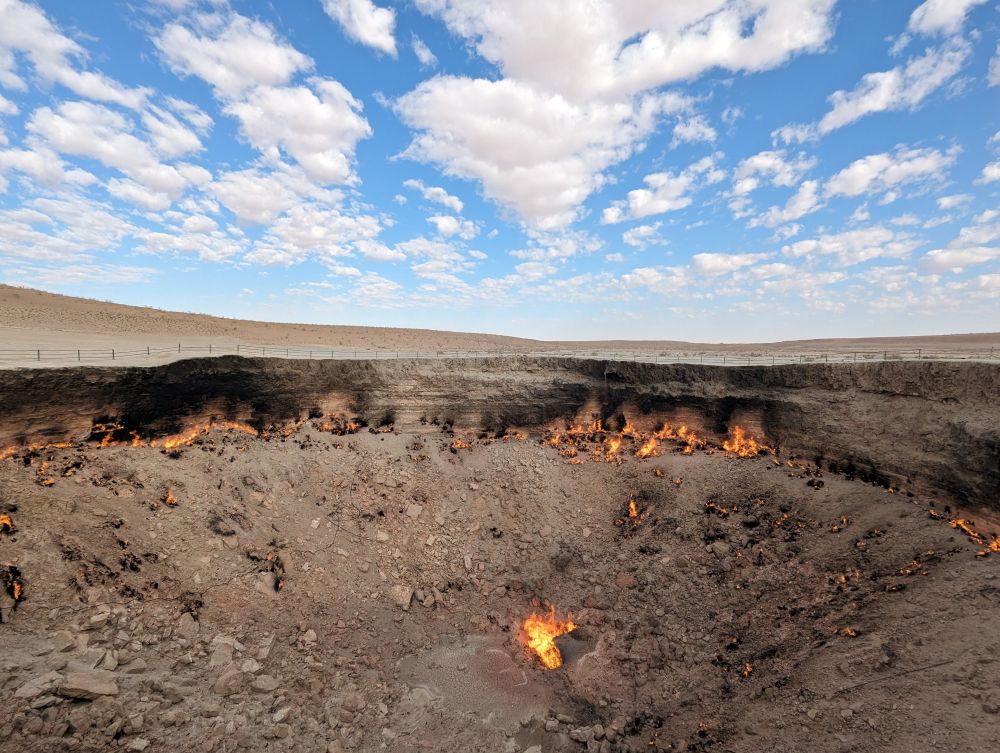
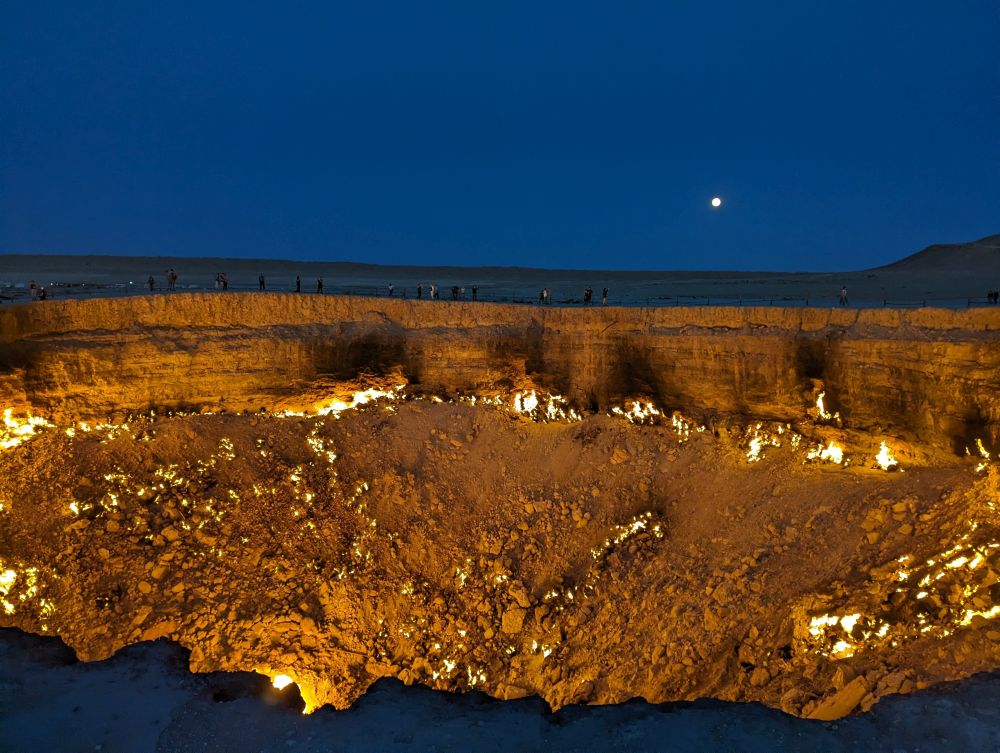
At YPT, we consider ourselves the Turkmenistan experts. We were the first company to bring tourists to the country after COVID, and continue to provide a large percentage of the estimated 5,000 visitors to this mysterious Central Asian Republic.
Therefore, it’s only right that we bring you the ultimate, comprehensive guide to Turkmenistan’s most famous – or infamous – tourist attraction. Here is everything you need to know about the Gates of Hell!
So, how did Darvaza come into being?
The History of the Gates of Hell is not straightforward.
The Karakorum Desert, which covers 80% of the country, is the twelfth largest desert in the world. More importantly for our story, however, it has underneath it the world’s fourth largest supplies of natural gas.
Back in the 1950s, the Soviet Union – which the region was then a part of – began serious gas exploration in Turkmenistan. However, one of the side effects of gas exploitation is sinkholes, given that gas pockets under the ground collapse in on themselves when the gas inside is drained from them.
While there are contradictory accounts, the general story goes that the Gates of Hell was formed in a similar way back in 1971. The Soviets, concerned that locals would rebel after the death of a local shepherd by the seeping gas, set the crater on fire. The plan, they hoped, was that burning off the gas -rather than it being released naturally – would avoid similar further deaths.
The Soviet engineers predicted the gas would take nine months to burn off. Not that we probably need to point this out, but the fact it is still burning today is an embarrassing testimony of how wrong they were.
And as to how long it will continue to burn? No one knows exactly, and rumours circulate all the time that the crater’s extinguishing – whether naturally or deliberately by the Turkmen government – could be just around the corner. We’ve actually written a seperate article on this topic that you can read here!
When did the Gates of Hell become an tourist attraction?
After it was set on fire in 1972, not much happened until a few years ago. Tourism was hardly easy in the former USSR to begin with, and Turkmenistan was one of the further outposts of the vast empire.
Indepenent Turkmenistan didn’t exactly rush to bring people here, either. They has previously ignored the crater, considering it an embarrassment, with tourism to the country never getting above a few thousand people a year. The truly determined could make it here – as one undercover journalist did back in 2006 – but otherwise it remained an off-the-beaten-path attraction in an already obscure nation.
Come 2017, however, and the Turkmen government was keen to cash in on some tourism. They realized the potential of the Gates of Hell, brought it on to mainstream tourist itineraries, and even included images of it in their Asian Games opening ceremony.
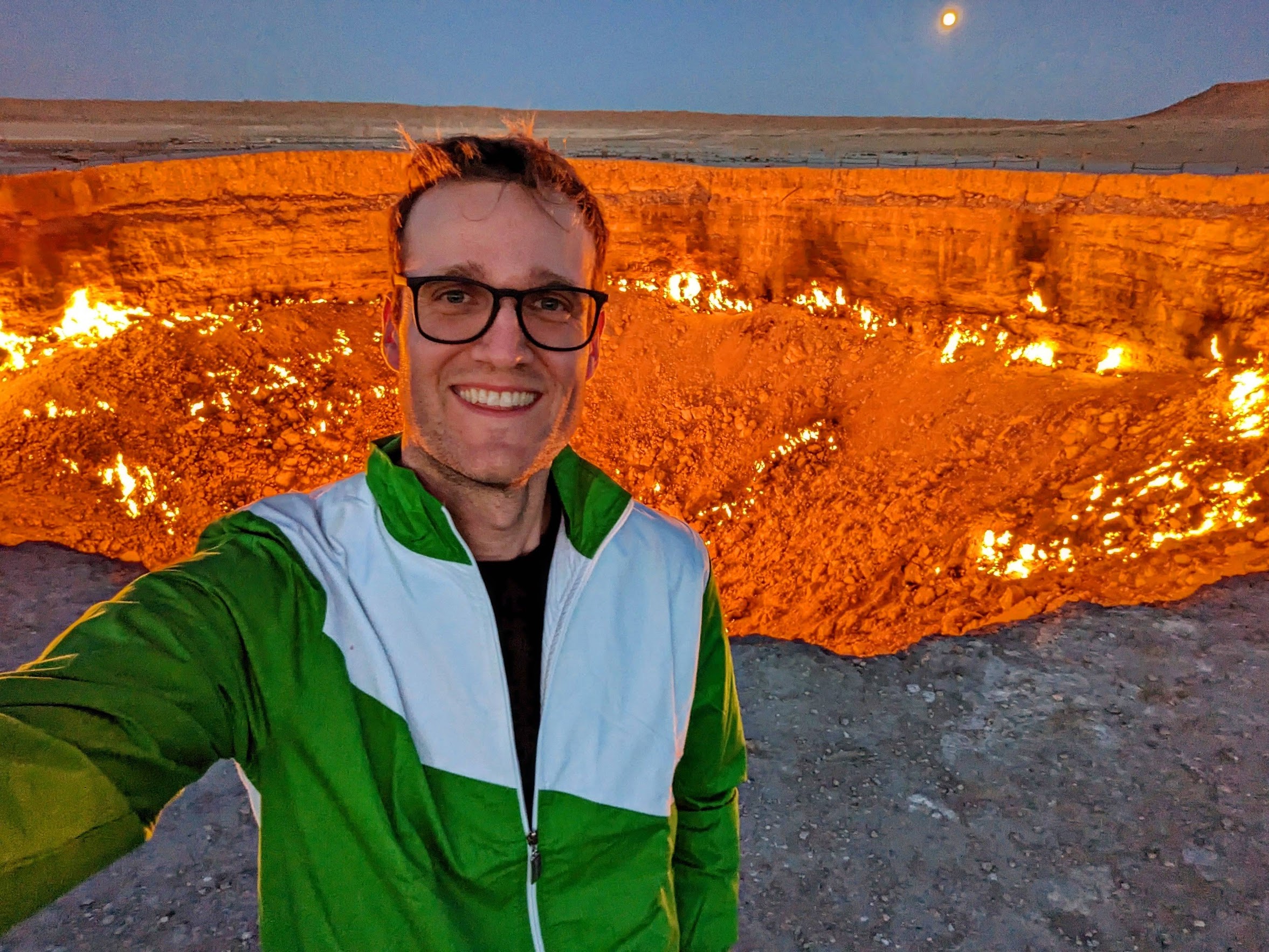
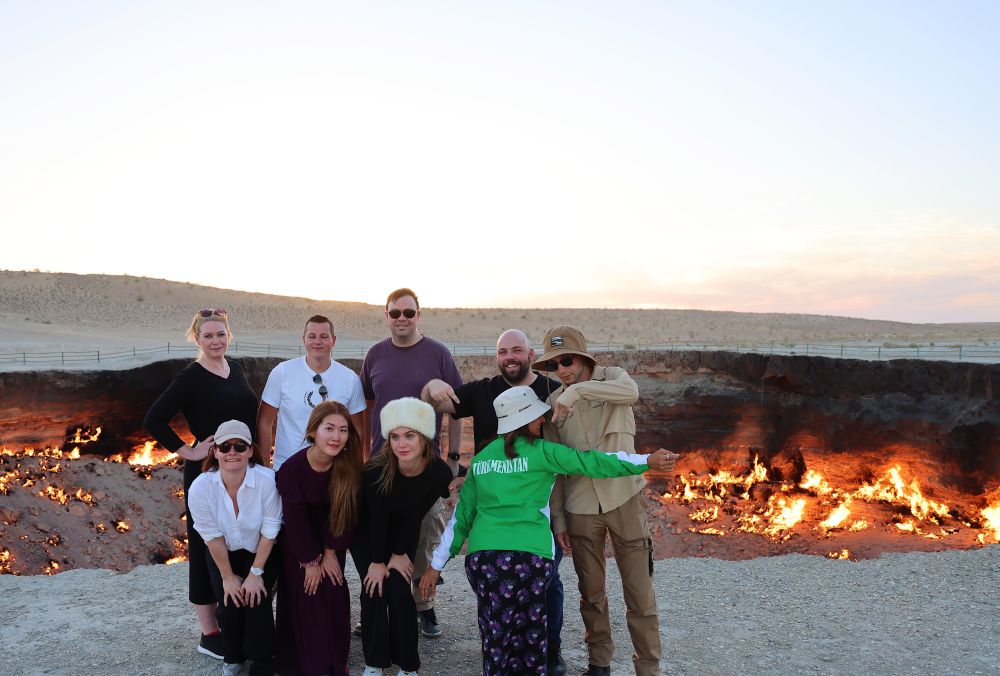
While this acknowledgment has brought downsides, including a (very small) fence being built for a cross-country car rally, there have been welcome improvements to the crater’s (non-existent) infrastructure. As a result, lots of tourists who never would have previously gone there have made it to the Gates of Hell. Now, there is even onsight yurt accommodation and a lit carpark!
Since then, and despite its ominous name, the Darvaza Crater has become a symbol of Turkmenistan’s unique natural wonders. It continues to attract adventurous and curious travellers from around the world.
What is it like witnessing the Darvaza Crater?
Simply put, visiting the crater is an intense, multi-sensory experience that will stay with you for the rest of your life.
Even as you arrive, you hear the crackling of the flames, the faint smell of burning gas, and the heat on your skin. Then, as the sun sets and the flames grow stronger before the naked eye, you’re further immersed in the dramatic spectacle of the crater, as if in a show. There’s a strange beauty to Darvaza.
The surreal beauty of the Gates of Hell is perhaps best captured in this account from a recent Pioneer visiting Darvaza:
Other than an intermittent convoy of trucks, it was just us, the dunes, and a few patches of ankle-high shrubbery as we drove through the Turkmen desert toward our most anticipated destination of our epic trip.
There was just after the scattered remains of the town of Darvaza, demolished on the President’s command, and a beautiful modern road bridge alone on the side the road. With barriers and street lights, we came to an astounding realization – there was no way of driving on or off it.
A couple of kilometres down the road, a dusty sign pointed west. Opposite it, a variety of tracks led towards the dunes. Following the tracks, we crossed a small ridge, at which point the tracks disappeared and we proceeded to skid through loose, deep sand.
We seemed to be going around in circles, with no landmarks besides the continuous dunes. Eventually, though, we crossed a narrow ridge that dissected two sandy mounds. As we descended, we were speechless as a fierce glow emerged from the giant flaming crater, suddenly visible on the plain ahead of us.
Awestruck, we jumped out of the car and ran down the valley towards the flames, the Gates of Hell. As we neared the edge of the crater, the enormity of this unnatural phenomenon baffled us. A failed exploration of Turkmenistan’s vast natural gas reserves had resulted in this vast crater, which was then set on fire in the hope it would quickly burn off. It hadn’t. Now, there was this giant crater, 70 metres in diameter, that had been on fire for over four decades.
We were instinctively drawn to the edge, perfectly aware yet disturbingly immune to any sense of fear. This allowed us to see for ourselves the reality of the imagery of this place’s name, colloquially known as “the Gates of Hell”.
One gigantic flame swirled out from the centre of the hole, curling several metres into the air. Smaller flames seeped out from cracks in the rocky walls, only to blur in the haze. We watched the burning crater all evening, taking us from dusk well into the night, being amazed by the intensity of the colour against the night backdrop. The heat was intense which, along with sand from the desert floor, was caught in the wind to throw itself back at us. While making for an uncomfortably dusty evening, this became insignificant compared to the elation from the red glow rising from the earth in front of us.
Had this man-made natural disaster happened in almost any other country in the world, it would not be the same experience. Most countries would put out the fire, bowing to the international pressure that would surely be placed on a government hosting such an environmental hazard. Many countries would leave it burning, simply for the sake of attracting tourism.
They would charge an extortionate entrance fee, litter the place with excessively friendly tour guides, cover it with vibrant information boards, and encourage small business owners to set up shops selling a smorgasbord of cold drinks, snacks, and hideous, overpriced souvenirs. Tourist bureaus would build some sort of walkway over the top, there might be a photography service available, and a vaguely comprehensive safety railing would be needed to keep up with required regulations.
A clever investor would likely build swanky apartment blocks. It wouldn’t be long until an international hotel chain would set up shop, advertising rooms with either “desert view” or “Gates of Hell view”.
Not only had none of this come to fruition in Turkmenistan, but the awesomeness of being one of the few people who have been present at this unique scene cannot be fully expressed. For the vast majority of the time, there is not a single soul at the crater.
It brings to mind the old adage: does a tree that falls in an empty forest still make a sound as it hits the ground? Does the burning gas crater still burn if there’s no one there to watch it?
But how long will it last?
Is Darvaza Crater safe?
A hole spewing fire in the desert does require caution – after all, falling into the Gates of Hell would not be pretty. In an attempt to keep people safe, the Turkmenistan government built a fence around the crater, although it is clear it has seen better days. Even once up close, you need to be mindful of the heat. The hot air packs a mighty punch, and your eyes might face temporary blindness.
In terms of safety, another point to consider is what you don’t see – the gas causing the flames. Whilst methane itself is not dangerous, what is poisonous is when it displaces oxygen. Inevitably, this means that there is less oxygen available to breath, which has adverse effects on health after long. That’s why it is essential not to get too close – listen to your body and use common sense!
Overall, though, the Darvaza Crater is generally safe to visit. However, please cautious around the crater’s edge, especially at night when visibility is limited. The ground around the crater can also be uneven, so watch your step to avoid accidents. Our YPT guide and local staff will also be there with a watchful eye, ensuring safety protocols are in place.
Can you stay at Darvaza?
In a word, yes! Staying in the yurts near the Gates of Hell offers a unique and immersive experience in the heart of the Karakum Desert. On our tours, we stay overnight, which allows us to enjoy the crater in all its glory – at sunrise, sunset, and the crater’s glow in the empty desert.
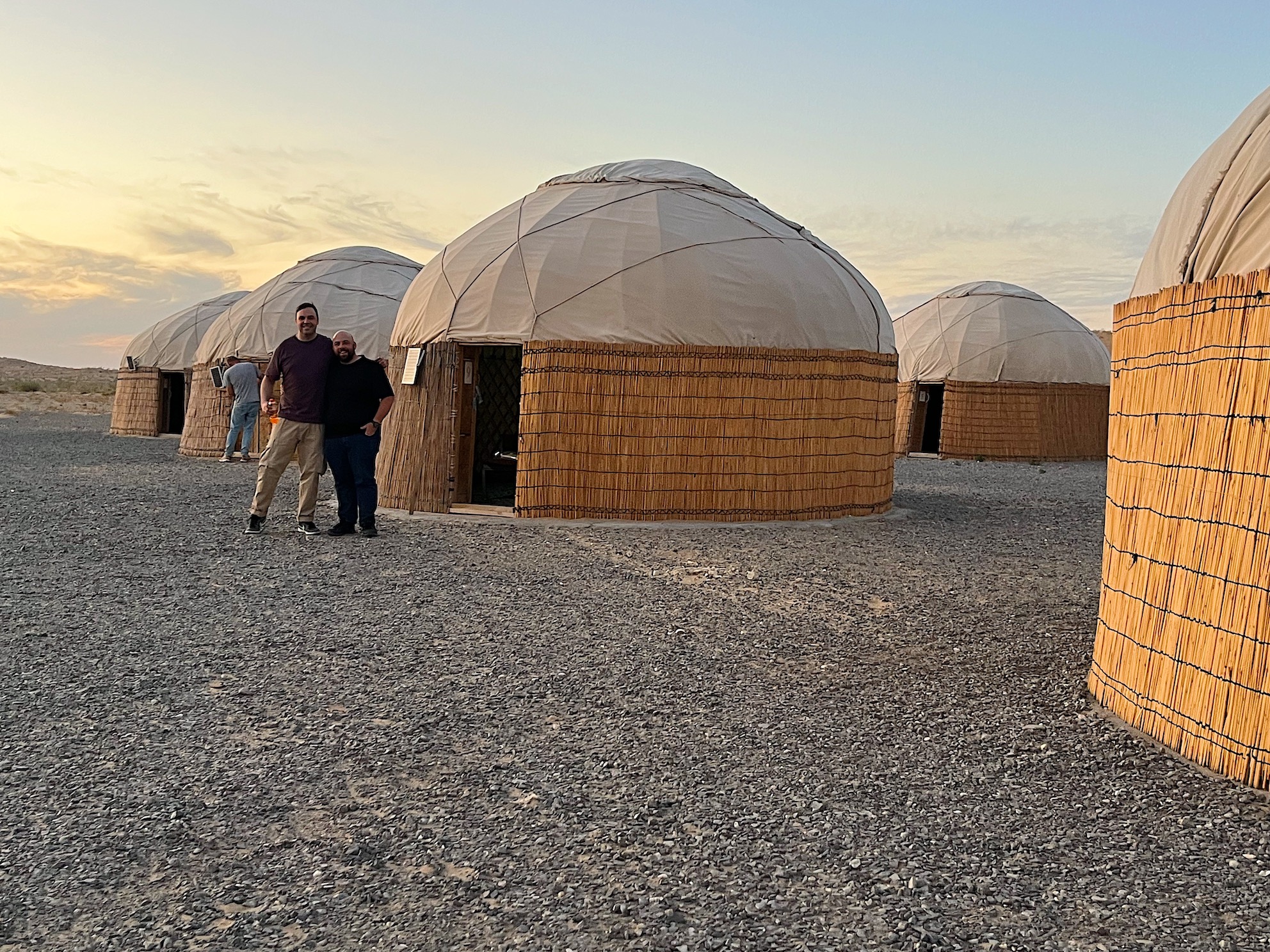
The camp is set up about 1.5km from the crater, and the yurts are of a traditional style. This gives the opportunity to see the primary homes that Turkmens have stayed in for thousands of years. Upon staying in one, there is little surprise as to how they have stood the test of time – a sturdy, reliable way to be protected from the environment.
So, not only do staying in the yurt give you a genuine glimpse into the region’s nomadic heritage, but they now include beds, linens, and sometimes even basic electricity.
In the West, it would likely be called glamping.
Preparing for the Gates of Hell:
If you join a YPT tour, then everything is organized for you! Along with our local partners, we ensure your permits, blankets, bedding, and even a hearty BBQ dinner! While have you covered, however, here are a few tips that may help you along the way:
Clothing: Pack appropriate clothing for the desert environment. Light, breathable clothing is recommended to cope with the daytime heat, while warm layers are necessary for the cooler nights. Remember to bring a hat, sunglasses, and sunscreen for sun protection.
Photography: Bring a camera or smartphone to capture the incredible scenery! If you want to get some of the best photos ever, this is your chance. A flash goes a long way, as well! Remember though to bring enough memory cards and batteries to last throughout your visit.
Before your tour, we will send out a packing list explicitly catered to when you visit in case, of any seasonal changes!
Eating and drinking at the crater:
As mentioned, you will have no problems here! The camp provides a full barbeque accompaigned with authentic Turkmen cuisine. This includes dishes such as plov (rice pilaf with meat and vegetables), kebabs (grilled meat skewers), shurpa (meat and vegetable soup), and various breads such as flatbread and Central Asian non.
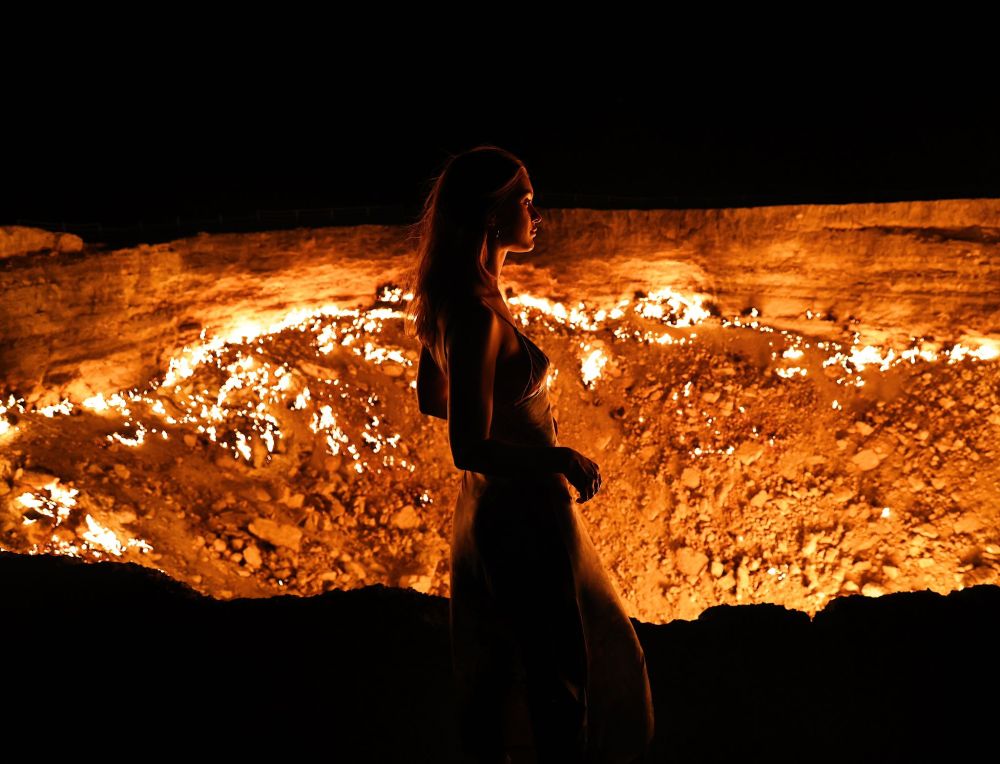
And vegetarians need not fear! While Turkmen cuisine is meat-heavy, we accommodate vegetarians with meat-free versions of common dishes, as well as salads, breads, and other options.
We also make a point to visit a large supermarket in Ashgabat before driving to Darvaza. This allows you to stock up on snacks, drinks, and any alcoholic beverages you may want to enjoy!
Visiting the Gates of Hell on tour:
Each of us have our own reason for wanting to see Darvaza. On our recent summer tour, we all took a minute of silence on the crater’s edge to observe our gratitude, privileges, and our opportunity to be amongst something so unique and beautiful. Some walked around it, and afterwards promised to go on and to do whatever they sought. For many, it is simply magical.
The Darvaza Gas Crater offers a one-of-a-kind travel experience, combining adventure, natural wonder, cultural immersion, and environmental curiosity. This makes the Gates of Hell a compelling destination for a diverse a of travelers. Unsurprisingly, it is a bucket-list item for so many.
So, take a leap of faith, sign up, and visit the Gates of Hell on one of our tours.
Many places claim to be the “real deal.” This is it.





